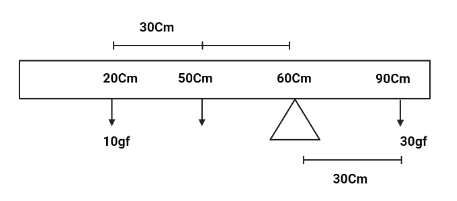
Answer
377.4k+ views
Hint:Since the metre scale has a constant density, the ruler's centre of gravity would be in the middle. According to the theory of moments, an object is in equilibrium if the number of anticlockwise moments about the same pivot equals the sum of clockwise moments.
Complete step by step answer:

The mid-point of the meter scale is $50\,cm$ , let us denote this weight as $W$. Now, we know that two moments will act on the meter scale, that is clockwise and anticlockwise.
Let us first calculate clockwise moment:
The formula to calculate the clockwise moment is: Mass × Distance of the weight from pivot.
It is given in the question that $mass = 30$ and Distance of the weight from pivot $90 - 60 = 30\,cm$.
Substituting the values we get,
$30 \times 30 \\
\Rightarrow 900gf.cm \\ $
Now, Let us calculate anticlockwise moment:
The formula to calculate the anticlockwise moment is: Mass × Distance of the weight from pivot.
It is given that there are two $mass = 10$ and $W$ and Distance of the weight from pivot $60 - 20 = 40cm$ and $60 - 50 = 10cm$ respectively
Substituting the values we get,
$10 \times 40 + W \times 10 \\
\Rightarrow 400 + 10W \\ $
According to the principle of moment,
Anticlockwise moment =Clockwise moment.
$900 = 400 + 10W \\
\Rightarrow 900 - 400 = 10W \\
\Rightarrow 500 = 10W \\
\therefore W = 50\,gf \\ $
Hence, the weight of the meter scale is $50\,gf$.
Note:A metre is a measurement unit that is used to determine the length of an object. A metre scale is used to determine the length of an item. A metre scale is graduated (or marked) in 100 centimetres, with each centimetre divided into ten millimetre divisions.
Complete step by step answer:

The mid-point of the meter scale is $50\,cm$ , let us denote this weight as $W$. Now, we know that two moments will act on the meter scale, that is clockwise and anticlockwise.
Let us first calculate clockwise moment:
The formula to calculate the clockwise moment is: Mass × Distance of the weight from pivot.
It is given in the question that $mass = 30$ and Distance of the weight from pivot $90 - 60 = 30\,cm$.
Substituting the values we get,
$30 \times 30 \\
\Rightarrow 900gf.cm \\ $
Now, Let us calculate anticlockwise moment:
The formula to calculate the anticlockwise moment is: Mass × Distance of the weight from pivot.
It is given that there are two $mass = 10$ and $W$ and Distance of the weight from pivot $60 - 20 = 40cm$ and $60 - 50 = 10cm$ respectively
Substituting the values we get,
$10 \times 40 + W \times 10 \\
\Rightarrow 400 + 10W \\ $
According to the principle of moment,
Anticlockwise moment =Clockwise moment.
$900 = 400 + 10W \\
\Rightarrow 900 - 400 = 10W \\
\Rightarrow 500 = 10W \\
\therefore W = 50\,gf \\ $
Hence, the weight of the meter scale is $50\,gf$.
Note:A metre is a measurement unit that is used to determine the length of an object. A metre scale is used to determine the length of an item. A metre scale is graduated (or marked) in 100 centimetres, with each centimetre divided into ten millimetre divisions.
Recently Updated Pages
How many sigma and pi bonds are present in HCequiv class 11 chemistry CBSE

Mark and label the given geoinformation on the outline class 11 social science CBSE

When people say No pun intended what does that mea class 8 english CBSE

Name the states which share their boundary with Indias class 9 social science CBSE

Give an account of the Northern Plains of India class 9 social science CBSE

Change the following sentences into negative and interrogative class 10 english CBSE

Trending doubts
Fill the blanks with the suitable prepositions 1 The class 9 english CBSE

Which are the Top 10 Largest Countries of the World?

Give 10 examples for herbs , shrubs , climbers , creepers

Difference Between Plant Cell and Animal Cell

Difference between Prokaryotic cell and Eukaryotic class 11 biology CBSE

The Equation xxx + 2 is Satisfied when x is Equal to Class 10 Maths

Change the following sentences into negative and interrogative class 10 english CBSE

How do you graph the function fx 4x class 9 maths CBSE

Write a letter to the principal requesting him to grant class 10 english CBSE



